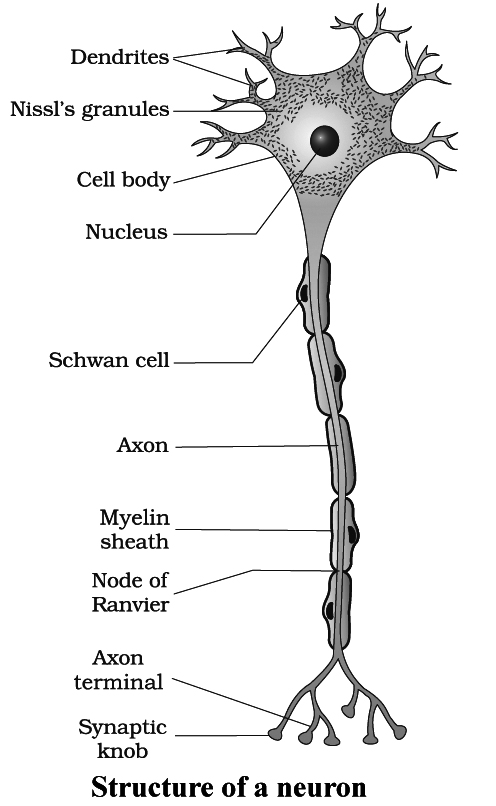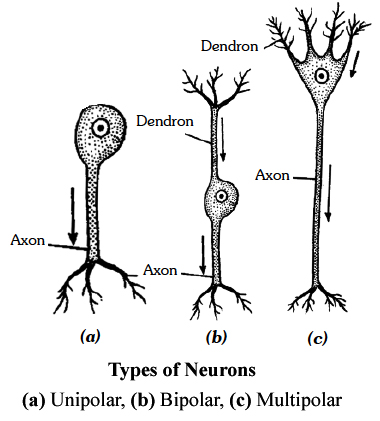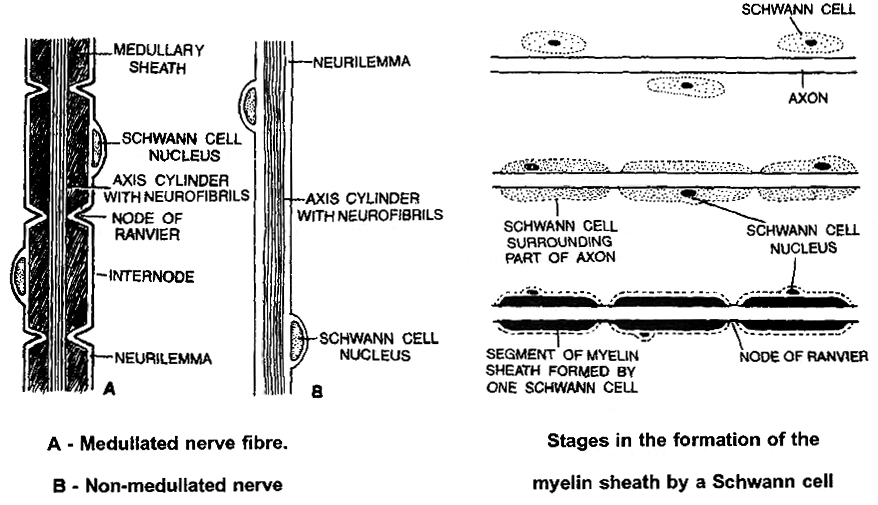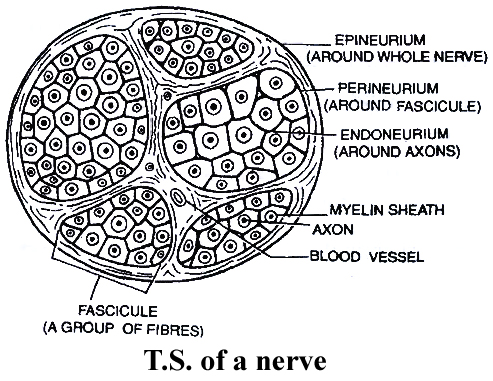- Books Name
- ACME SMART COACHING Biology Book
- Publication
- ACME SMART PUBLICATION
- Course
- CBSE Class 11
- Subject
- Biology
NERVE TISSUE

Ordinary connective tissue is absent inside the central nervous system, the neurons are held together by supportive cells called Neuroglia Cells. Nerve tissue is made of neurons and neuroglia cells.
A Neuron has a large cell body with two or more, thin protoplasmic processes extending from it.
One of the processes called the Axon is long and conducts nerve impulses away from the cell body.
It ends in a number of small branches on muscle fibres, gland cells or other neurons.
The remaining one or more processes conduct nerve impulses towards the cell body and are called Dendrites or Dendrons.
The axon terminals may form intercommu- nicating junctions, called Synapses, with dendrite terminals, cell bodies or even axons of other neurons.
Nerve impulses pass between neurons through the synapse with the help of chemicals such as acetylcholine which are termed Neurotransmitters.
The cell body of a neuron is called the Soma.
The soma has various shapes.
Both the soma and the processes are covered by the plasma membrane.
The soma contains abundant granular cytoplasm and a large nucleus.
To serve the high energy needs for impulse conduction, neurons have many mitochondria.
Light microscopy shows many small conical, angular or rhomboidal and highly basophilic structures in the cytoplasm of soma and dendrites, called Nissl Bodies which are absent in the axon and the axon hillock. Nissl's bodies are made of ribosomes, ER, m-RNA.
The processes which arise from neuron are called as neurites. These are of two types-Dendrites, Axon.
(i) Dendrites conduct the nerve impulse towards the nerve cell body and are called as afferent processes.
(ii) Axon is a single, usually long process. The part of cyton from where the axon arises is called as axon hillock. The cell membrane of the axon is called axolemma and its cytoplasm is known as axoplasm. The axon divides to form axon ending ; each with a synaptic knob. The synaptic knobs contain mitochondria and secretory vesicles. The vesicles contain neurotransmitters which are nor-adrenaline, adrenaline or Acetyl choline etc.
SYNAPSE
Nerve signals travels from neuron to neuron all over the body.
These associations are called synapses.
Synapse is a junction between axon endings of one nerve fibre and dendrite of the other.
At a synapse, the membrane of axon and dendrites are not in physical contact with each other but there is a narrow intercellular gap, 10 to 20 nanometres across, separating the axon tip and the target cell.
This gap is Synaptic cleft. The neurotransmitter is always released from axon endings and not by dendrites, so there is only one way transmission of nerve impulse.
Types of Neurons

The neurons are of four types based on the number of nerve processes.
(i) Unipol'ar neurons : Which have only axon but no dendron and are found only in early embryos.
(ii) Bipolar neurons : Which have two processes, one axon and another dendron, and are found in olfactory epithelium and retina of eye.
(iii) Multipolar neurons: Which have many processes arising from cell body; out of them one is (longer) acts as an axon and the remaining as dendrites. Multipolar neurons are most common and are found in brain and spinal cord.
(iv) Pseudo-unipolar neurons: They are actually bipolar but appear like unipolar. A single process arises first which divides to form dendrite and axon. This is found in dorsal root ganglion of the spinal cord.
Non-polar Neurons: Each neuron bears several branched processes which are not differentiated into axon of dendrite.
On the basis of function, neurons are of three types:
(i) Sensory (Receptor or Afferent) Neurons: They connect sense organs with the central nervous system (brain and spinal cord).
(ii) Motor (Effector or Efferent) Neurons : They connect tile central nervous system to the effectors (muscles and glands). They carry motor impulses from the central nervous system to the effectors.
(iii) Interneurons (Connector, Relaying or Adjustor Neurons) : They are present in the central nervous system and occur between the sensory and motor neurons for distant transmission of impulses. They are neither sensory nor motor.
Extended axon or dendrite of a neuron is called a nerve fibre. It is generally elongated axon. There are two basic types of nerve fibres :
(i) Myelinated/Medullated nerve fibres are with the myelin sheath. Myelin sheath is formed by the spiral wrapping of Schwann cell membrane around the axon. Outside the myelin sheath, neurilemma is present. Myelin sheath is absent at certain points called Nodes of Ranvier. In myelinated nerve fibres, the impulse jumps from one node of Ranvier to the other, this is called saltatory conduction of the impulse. Node of Ranvier is without myelin but with Neurilemma. Myelinated nerve fibres are found in cranial and spinal nerves.

(ii) Non-myelinated/non-medullated nerve fibres are not covered with myelin sheath. They are called non-myelinated or non-medullated nerve fibres. They do not possess nodes of Ranvier, but have neurilemma. Myelinated nerve fibres are generally thicker than non-myelinated ones. These fibres are enclosed by Schwann cell that do not form a myelin sheath around these axons and are commonly found in autonomous and the somatic neural system.
Nerve:

A nerve is a collection of nerve fibres surrounded with connective tissue membranes.
The membrane of the nerve fibre is neurilemma; outside this, each nerve fibres is surrounded by a layer of connective tissue called the Endoneurium.
A nerve consists of several bundles of nerve fibers called fasiculi.
Each fasiculum is surrounded by a layer of connective tissue called the perineurium.
A dense layer of connective tissue that surrounds the entire nerve made of a number of fasiculi is called Epineurium.
A nerve can be :
(i) Sensory Nerve: It is made up of only sensory nerve fibres surrounded by connective tissue membrane. It carries the impulse from the receptor to CNS.
(ii) Motor nerve : It is made up of motor nerve fibres, which carry the impulse from CNS to the effector organs i.e., muscles or glands to bring about their movement.
(iii) Mixed Nerve: It has both the sensory and motor nerve fibres. All the spinal nerves in our body are mixed.
NEUROGLIA CELLS / GLIAL CELLS
They are undifferentiated cells with no Nissl's granules.
(i) Astrocytes / Macrocytes -They are large in size with a number of protoplasmic processes. They form maximum number of glial cells. They help in repair of nerve tissue and form blood brain barrier.
(ii) Oligodendrocytes - They are with few protoplasmic processes and form myelin sheath in eNS.
There is no neurilemma inside the central nervous system. In the absence of Schwann cells, myelin is formed by the spiral wrapping of the nerve fibres by processes of Oligodendrocytes. They are a type of neuroglia cells.
(iii) Microglial cells - They are mesodermal in origin. They are smallest in size with few feathery processes and help in phagocytosis.

Different kinds of neuroglial cells.
A. Fibrous astrocyte. B. Protoplasmic astrocyte C. Oligodendrocyte. D. Microglial cell.
SUMMARY
Cells, tissues, organs and organ systems split up the work in a way that ensures the survival of the body as a whole and exhibit division of labour.
A tissue is defined as group of cells along with intercellular substances performing one or more functions in the body.
Epithelial tissues are sheet like tissues lining the body's surface and its cavities, ducts and tubes.
Epithelia have one free surface facing a body fluid or the outside environment.
Their cells are structurally and functionally connected at junctions.
Epithelial tissue is classified into different categories on the basis of shape and function of cell.
Diverse types of connective tissues bind together, support, strengthen, protect and insulate other tissue in the body.
Soft connective tissues consists of protein fibres as well as a variety of cells arranged in a ground substance.
Cartilage, bone, blood, and adipose tissue are specialised connective tissues.
Cartilage and bone are both structural materials.
Blood is a fluid tissue with transport functions.
Adipose tissue is a reservoir of stored energy.
Muscle tissue, which can contract (shorten) in response to stimulation, helps in movement of the body and specific body parts.
Skeletal muscle is the muscle tissue attached to bones.
Smooth muscle is a component of internal organs.
Cardiac muscle makes up the contractile walls of the heart.
Connective tissue covers all three types of tissues.
Nervous tissue exerts greatest control over the response of body.
Neurons are the basic units of nervous tissue.

 Maria Habib
Maria Habib
